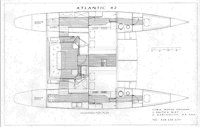The Atlantic 42 design, while not exactly a "small" boat is in my opinion about the smallest size cruising cat that still works well. It has the ability to carry enough gear and stores for comfortable long term use without being over burdened. Loaded with all normal stores for a passage she is still an excellent sailing cat, often making more than 200 miles per day. (The best days run that I know about was reported at 267nm.) In the right conditions steady speeds of 15 to 17 knots are fairly easy to achieve and occasionally 20 knots is reported by owners. However the big selling point to my way of thinking is the ease and comfort with which the 8 to 12 knot range is maintained. This is how you get places.
Speed under power is very handy at times and the Atlantic 42 will slide along at 8 knots powered by twin Yanmar 27 HP diesels. The wide separation of the props allows excellent maneuverability under power, which offsets the wide beam penalty while docking and in very tight harbors. With practice it is possible to motor through a mooring field in REVERSE with a strong cross wind. Spinning the cat is possible by using full reverse on one engine with forward on the other. I've timed more than two 360 degree revolutions in a minute while sitting stationary. Torque like this can be very handy when the wind has you pinned to the fuel dock.
Since my first sail on a cat with the conventional aft cockpit I've objected to the notion of trying to sail a boat from behind a six foot high bulkhead. You can't see forward very well - or at all in some designs - and you can't feel the breeze. My solution was to reverse that layout and put the cockpit forward of the deck house. This is the trademark feature of the Atlantic series catamarans. With the cockpit in the middle of the boat, just behind the mast, very easy and safe sail handling is possible. The mainsail can be reefed without leaving the cockpit and within arms reach of wheel, halyard and mainsheet. When sailing, the A42 feels more like a flush decked race boat than a Greyhound Bus.
But after a few hours of being out in the weather, most sailors are looking for shelter. Two steps behind the cockpit is the nerve center of the boat, the pilothouse. From this vantage the A42 can be steered, navigated and presided over. There is excellent visibility of the sails and horizon all around as well as plenty of ventilation. It is the watch keeping station of choice and the living room of the boat. During my first night watch onboard an Atlantic cat in October 1985 all I could do was laugh as I sat warm and dry watching the cold spray unable to reach me behind tempered glass.
Within the hulls there are dedicated spaces for sleeping, cooking and bathing. The emphasis is on seagoing comfort and functionality rather than sit-at-the-dock "curb appeal" and spaciousness. There are ample lockers for tools and gear, a dedicated workbench, a wonderful shower area that gets toasty warm when the heat is on and a super galley that can be safely used in the roughest weather. Each hull contains two separate sleeping cabins that share a head located between them. The midship cabin has a queen sized double berth, the forward cabin has a single bunk. The interior layout works very well for a family or a cruising couple with occasional guests.
I've had the good fortune to sail a number of catamarans of my own design. I can say that the Atlantic 42 is one of the most versatile cats out there. She has lots of capability in a relatively small package and a reasonable cost. It continues to be a very popular design.
Chris White


